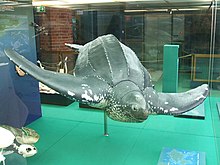Dermochelyidae: Difference between revisions
Appearance
Content deleted Content added
m →Bibliography: Task 16: replaced (1×) / removed (0×) deprecated |dead-url= and |deadurl= with |url-status=; |
Sun Creator (talk | contribs) Remove stub template. |
||
| Line 102: | Line 102: | ||
[[Category:Tarantian taxonomic families]] |
[[Category:Tarantian taxonomic families]] |
||
[[Category:Holocene taxonomic families]] |
[[Category:Holocene taxonomic families]] |
||
{{Turtle-stub}} |
|||
Revision as of 14:57, 1 November 2019
| Dermochelyidae | |
|---|---|

| |
| Dermochelys is the only living representative of the leatherback turtles. | |
| Scientific classification | |
| Domain: | Eukaryota |
| Kingdom: | Animalia |
| Phylum: | Chordata |
| Class: | Reptilia |
| Order: | Testudines |
| Suborder: | Cryptodira |
| Superfamily: | Chelonioidea |
| Family: | Dermochelyidae Fitzinger, 1843[1] |
| Genera | |
| Synonyms[1] | |
| |
Dermochelyidae is a family of turtles which has seven extinct genera and one extant genus, including the largest living sea turtles.
Classification of known genera
The following list of dermochelyid species was published by Hirayama and Tong in 2003, unless otherwise noted.[2]
- †Arabemys crassiscutata
- †Eosphargis breineri
- †Mesodermochelys undulatus
- Subfamily Dermochelyinae[3]
- †Cosmochelys
- Dermochelys coriacea – leatherback sea turtle[3]
- †Psephophorus

Phylogeny
Evers et al. (2019):[4]
References
- ^ a b Rhodin 2011, p. 000.174
- ^ Hirayama, R.; Tong, H. (2003). "Osteopygis (Testudines: Cheloniidae) from the Lower Tertiary of the Ouled Abdoun phosphate basin, Morocco". Palaeontology. 46 (5): 845–856. doi:10.1111/1475-4983.00322.
- ^ a b "Natural history of seas turtles: paleontologic history" (PDF): 21–2.
{{cite journal}}: Cite journal requires|journal=(help) - ^ Evers, Serjoscha W.; Barrett, Paul M.; Benson, Roger B. J. (2019-05-01). "Anatomy of Rhinochelys pulchriceps (Protostegidae) and marine adaptation during the early evolution of chelonioids". PeerJ. 7: e6811. doi:10.7717/peerj.6811. ISSN 2167-8359. PMC 6500378. PMID 31106054.
{{cite journal}}: CS1 maint: unflagged free DOI (link)
Bibliography
- Rhodin, Anders G.J.; van Dijk, Peter Paul; Inverson, John B.; Shaffer, H. Bradley; Roger, Bour (2011-12-31). "Turtles of the world, 2011 update: Annotated checklist of taxonomy, synonymy, distribution and conservation status" (PDF). Chelonian Research Monographs. 5. Archived from the original (PDF) on 2012-01-22.
External links
Kategorien:
- Dermochelyidae
- Taxa named by Leopold Fitzinger
- Turtle families
- Extant Late Cretaceous first appearances
- Santonian first appearances
- Santonian taxonomic families
- Campanian taxonomic families
- Maastrichtian taxonomic families
- Danian taxonomic families
- Selandian taxonomic families
- Thanetian taxonomic families
- Ypresian taxonomic families
- Lutetian taxonomic families
- Bartonian taxonomic families
- Priabonian taxonomic families
- Rupelian taxonomic families
- Chattian taxonomic families
- Aquitanian taxonomic families
- Burdigalian taxonomic families
- Langhian taxonomic families
- Serravallian taxonomic families
- Tortonian taxonomic families
- Messinian taxonomic families
- Zanclean taxonomic families
- Piacenzian taxonomic families
- Gelasian taxonomic families
- Calabrian taxonomic families
- Ionian taxonomic families
- Tarantian taxonomic families
- Holocene taxonomic families

